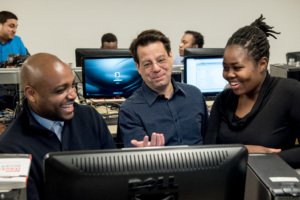How to Start Your IT Career: 7 Step Guide

In a time when the job market is uncertain, one thing remains constant – IT roles are evolving and available. The IT industry is rapidly growing, and there is a high demand for skilled professionals in various domains such as software development, cybersecurity, data analytics, tech support, and more.
With a wide range of career paths and opportunities, starting an IT career can be an attractive option for those looking to switch careers or enter a field with strong job prospects.
However, starting an IT career can be challenging without a clear understanding of the industry and the skills required to succeed.
In this article, we’ll provide a step-by-step guide on how to start your IT career. Even if you come from a different industry background.
How to Start Your IT Career: 7 Steps
Here’s our 7 step guide to starting your IT Career:
1. Research Different Tech Industry Careers
If you find yourself not knowing where to begin when it comes to starting a career in IT, you can start by doing some research. A quick browse for everything from entry-level IT jobs to tech industry careers will not only help you determine what route you’d like to take, but on a broader scale, it will also show you the many different paths you can take in tech. The possibilities for a career in IT are endless and it all starts with jumping in head-first.
The IT industry has various domains; from cybersecurity to help desk, each entailing its own specializations and avenues to go down in your IT career. Additionally, each domain has certain certifications that are helpful when entering that field.
There are many different career paths in the IT industry with different skills requirements and certifications. Here are a few that have proven to be successful:
- Cybersecurity: This is an important IT career path lately as hacking and information security has been a topic of interest throughout different industries. No matter what industry or company you are interested in, chances are there are open positions with cybersecurity. Successful cybersecurity careers entail various certifications such as Net+ and are often more advanced with qualifications.
- Software Engineering: This could involve project management and product development in any industry, making it a great path to get into for an IT career. With different skill levels to enter and advance to, this is an ideal career to go into for career advancement.
- Desktop Support: Desktop support careers are often a stepping stone for advancing in tech and especially to get experience in technology.
2. Develop your IT skills and Knowledge
Online, there are different options to develop IT skills. Research will reveal that you can self-learn, take part in online bootcamps or start programs for certifications. Choosing the right IT training program that matches your style of learning and Per Scholas offers courses remotely and in-person for IT training, and there are many ways to develop your IT technical skills through a learning resource that works best for you. Most impportantly, we recommend that you receive hands-on experience through bootcamp courses, training, and studying for your certifications. It’s important to have that hands-on training experience since it gives your more experience than what you may read in a book or watch on a video. Additionally, it puts your experience and knowledge ahead of others who are entering the IT industry.
3. Apply for our Systems Support Training
With so many options available, we believe one of the most crucial steps to starting a career in IT is to engage in a training program.
We recommend starting with our IT Support training or Desktop Support training, powered by TEKsystems. These courses, in particular, are great for getting your foot in the door in tech and learning IT fundamentals. No matter your previous experience in tech, Per Scholas makes sure you are caught up to speed and have the skills needed to launch your career in tech to land in one of the many IT roles available – as with any of our courses.
If you’re still not sure which program is right for you, we suggest you Contact our Recruitment Team with your interest. We are happy to help answer any questions you may have as you launch your career in tech. Together, we can figure out how to get you started at one of our IT training campuses.
4. Get Certified For A Career In IT
An IT certification doesn’t just look good on your resume; it helps translate your training and skills into real-life applications whichever tech career you choose to take on.
Per Scholas not only prepares learners for certifications and an IT career path, but we provide tuition-free training and pay for certifications under the completed course. With certifications and your tech skills, we know you will have the tools to start your IT career.
5. Network with Top Tech Industry Professionals
Networking does not get enough credit when it comes to its impact on launching your career in the tech industry. In a time where it’s not just what you know but who you know that matters, networking is key to a career change or next step.
We suggest networking with industry leaders in a position you aspire to be in and picking their brains on different IT roles, opportunities, and what they did to get where they are in their careers.
At Per Scholas, we connect our learners with tech industry professionals through mock interviews, company partnerships, and other professional development opportunities to ensure our learners have the chance to speak to others in the industry.
When it comes to discovering just how to start an IT career, Per Scholas possesses a wealth of resources for you to use to your best advantage.
6. Create your IT resume and portfolio
When creating your resume geared for an IT position, it is important that the content you provide is relevant to the job and showcases your technical skills as well as your soft essential skills. If you are far enough into your career to have a portfolio, include relevant information and items in that for interviewers and recruiters to review. What would you want to showcase from your past work and experience that sets you apart from other technologists?
7. Apply for IT jobs
Once you have the training, certifications, and resume, it’s time to take action and apply for IT jobs. There are a few ways to find IT job opportunities, including job boards, career fairs, and networking. Per Scholas connects our learners with hiring partners to discuss open positions and further network with industry experts. In applying and preparing for IT job interviews, be sure to research the company and the position you’re applying for, and practice common interview questions with responses that highlight your experience and strengths.
The interview process doesn’t stop once you are done interviewing. Be sure to follow up with the hiring manager, recruiter, and/or your interviewer to thank them for their consideration and to let them know about your excitement for the role.
Start Your Career in IT Today
It takes time and effort to launch a career in tech – no matter your background in IT. Making a career change or starting fresh in a new industry is a big deal that takes a lot of consideration, but with the right tools, training, and IT fundamentals, taking that first step towards one of many IT roles isn’t so daunting.
To get started on your own IT career, be sure to apply to one of our upcoming courses that have launched a career in IT for more than 20,000 learners trained, now leaders in the IT career field.
Advancing Hispanic and Latinx Presence in Tech
THE STATE OF DIVERSITY & INCLUSION IN TECH
Although there have been advancements over the years in the diversity of the tech field, the broad field of technology is still heavily dominated by white men, and now is a good time to celebrate the many accomplishments of our Hispanic and Latinx co-workers and learners while reflecting on the state of diversity in tech. Black, female, Latino/a, and other minorities remain greatly underrepresented throughout the tech industry.
In recent years, more emphasis has been put nationally on the importance of promoting diversity, equity, inclusion, and belonging (DEIB) in the workplace, but the tech industry still has a long way to go in becoming a more equitable workforce.
- For example, in 2014, Google, a subsidiary of one of the world’s largest tech companies, reported that only 2.9% of their employees were Latino/a.
- Google promised to commit over $150 million to increasing diversity at their company but, by 2020, just 5.9% of their workforce identified as Latino/a, a definite improvement, but nowhere near representative of the U.S. population.
- According to a 2021 analysis of federal government data by the Pew Research Center, Hispanic workers make up 17% of total employment across all occupations, but make up just 8% of tech workers.

WHY DIVERSITY, EQUITY, AND INCLUSION MATTERS
Currently, there are a myriad of barriers for minority individuals looking to enter the tech workforce. In addition to the bias and discrimination towards certain minorities that still, unfortunately, exist in a disproportionately high amount in the STEM fields, lack of access to opportunity and specified support within the tech field, our country’s digital divide, racial wage gaps, poverty, systemic inequalities, and even disparities in reliable internet access, are all barriers to entry for potentially talented individuals seeking to become involved in tech.
Creating pathways for more diverse talent to get involved in tech is the first step in building a diverse workforce. While tech training programs and bootcamps can help alleviate some barriers into the tech field by costing less and being quicker than the typical four-year degree, many are still prohibitively expensive and do not adequately target underrepresented groups for recruitment.
CELEBRATING HISPANIC HERITAGE
Each year, Per Scholas observes National Hispanic Heritage Month, from September 15th to October 15th, to celebrate the histories, cultures, and contributions of those and their ancestors who come from Spain, Mexico, the Caribbean, and Central and South America. A fun fact: 27% of Per Scholas’ staff and 14% of our learners identify as Hispanic/Latino!
 An important step in bringing more diversity to the tech field, beyond simply preparing learners to launch their careers, is showing people from various minority-in-tech backgrounds that success is possible for them in the tech field. In a 2021 study, the Pew Research Center found that over half of Hispanic Americans they surveyed felt that young Hispanic people would be a lot more likely to pursue a STEM degree if they saw examples of high achievers in the field who were Hispanic or Latinx. Earlier this year, Per Scholas partnered with executive advancement company Guerrero Media to create The Code Breakers: Women in Tech campaign. Each week, this campaign spotlights exemplary women who have built successful careers working in tech, breaking down barriers and paving the way for other minority technologists to pursue paths in tech.
An important step in bringing more diversity to the tech field, beyond simply preparing learners to launch their careers, is showing people from various minority-in-tech backgrounds that success is possible for them in the tech field. In a 2021 study, the Pew Research Center found that over half of Hispanic Americans they surveyed felt that young Hispanic people would be a lot more likely to pursue a STEM degree if they saw examples of high achievers in the field who were Hispanic or Latinx. Earlier this year, Per Scholas partnered with executive advancement company Guerrero Media to create The Code Breakers: Women in Tech campaign. Each week, this campaign spotlights exemplary women who have built successful careers working in tech, breaking down barriers and paving the way for other minority technologists to pursue paths in tech.
 One of our learners who was featured in this campaign is Sara Peña, a Latina woman from Boston who was working as a musician before making the bold decision to switch to a career in tech. Like many people, Sara found herself in a financial crisis during the Covid pandemic when she was laid off from her job. With no income and an insurmountable amount of student loans, Sara had to pivot to a more stable career. A friend mentioned she should look into coding, something Sara had once noted in passing as an interest, so she began researching different boot camps. Sara found Per Scholas through an online search and was intrigued by our mission and course offerings. She applied and was soon accepted into our Software Engineering course at Per Scholas Boston.
One of our learners who was featured in this campaign is Sara Peña, a Latina woman from Boston who was working as a musician before making the bold decision to switch to a career in tech. Like many people, Sara found herself in a financial crisis during the Covid pandemic when she was laid off from her job. With no income and an insurmountable amount of student loans, Sara had to pivot to a more stable career. A friend mentioned she should look into coding, something Sara had once noted in passing as an interest, so she began researching different boot camps. Sara found Per Scholas through an online search and was intrigued by our mission and course offerings. She applied and was soon accepted into our Software Engineering course at Per Scholas Boston.
Although the course was tough, Sara’s perseverance and dedication helped her through, and she thrived in the program. “It is no secret how daunting it is to…start anew in a career you never thought yourself capable of,” Sara reflected. “In moments where I thought this is too much, too hard, too overwhelming, I remembered in my heart of hearts, this is what I wanted to do and this opportunity was given to me. It was something that I didn’t want to put to waste.” Shortly after graduating, Sara started her new career as a Software Developer at engineering company nou Systems, where she has been continuing to learn. She is working toward earning further certifications and exploring all that the tech field has to offer.
- While women comprise 28.8% of the U.S. tech workforce, Latina women hold only 2% of jobs in STEM.
Spreading stories like Sara’s can help encourage other Latinos and minority individuals that success is possible for them in the tech field. Per Scholas learners of various ages, gender identities, races, ethnicities, physical abilities, and backgrounds have been able to launch thriving tech careers following Per Scholas’ courses. No one should be barred from pursuing a career in tech due to a lack of connection, and the success of our learners serves to encourage others to apply, breaking down barriers to entry in tech.
THE FUTURE OF THE TECH INDUSTRY
At Per Scholas, we are expanding in the future to different cities and doing our research to make sure there is a market that has plenty of job openings and diverse demographics to fill those openings with our skilled graduates. As we continue to train diverse individuals and diversify the tech workforce, we have to consider what the face of tech will look like in the future and how we get there.
With a more diverse workforce that includes the Hispanic and Latinx culture and history, more ideas and insight are at the helm of advancements. It has been reported that organizations ranking high in internal ethnic, gender, age, and cultural diversity regularly perform significantly higher than their industry peers in terms of financial returns and employee satisfaction. Both the business and social cases for diversity are strong. It is now up to individual companies to put in the work to improve the diversity of their workforces, and Per Scholas is happy to help facilitate the process.
The promotion of DEIB in the tech workplace begins with opportunity and intentionality. The IT field has a long way to go in order to become a totally diverse and inclusive community, but it is headed in the right direction. Per Scholas is committed to helping drive this change, transforming the face of technology by opening pathways of opportunity for diverse talent, showing minority-in-tech individuals that success is possible for them in the IT field, and helping other organizations create more inclusive, intentional, and equitable workforces.
We are committed to breaking down the barriers that keep people from entering the tech industry and our cost-free, high-quality tech training seeks to further open the pathway into tech for those who would otherwise not have had the opportunity.
Online vs In-Person Classes: Weighing the Pros and Cons
The ever-evolving landscape of education has seen the increasing popularity of remote and hybrid learning options over the last few years. This initial shift was largely spurred by the Covid pandemic, but the popularity of online learning options has remained high as people recognize the benefits that this form of learning can bring.
That being said, there are still many unique benefits that in-person learning offers. A number of learning institutions, including Per Scholas, now provide options for in-person, online, and hybrid courses. When deciding which learning option you would like to pursue, it is important to understand the significance of choosing the right mode of education that aligns with your individual needs, preferences, and goals.
Below, we will outline some of the benefits and detriments of online vs in-person classes in order to help readers make a more informed decision about the learning option that best suits their needs.
Advantages of Online Classes
As previously mentioned, the prevalence of online and hybrid learning has risen dramatically in the past few years, primarily during, and in the wake of, the Covid pandemic. However, remote learning has existed in some form or another for much longer than many people may realize: the first web-based courses have been around practically since the advent of the internet, with Jones International University launching in 1993.
The idea of remote learning actually dates back even farther to the 19th century, when the University of London pioneered the idea of correspondence-based courses. Of course, advances in technology have since made remote learning much more accessible, immersive, and comprehensive, making it a valid alternative to in-person courses.
There certainly are benefits to remote learning, evidenced by its long history and increased prevalence in recent years. Many people were forced to switch to remote learning during the pandemic, but have chosen to adhere to the learning style, even after social restrictions have been lifted.
1. Flexibility & Convenience
 One of the primary benefits of remote learning is the flexibility and convenience that it provides. While Per Scholas’ remote courses are not self-paced, they do allow learners to attend from the comfort of their own homes. This can be a great benefit, particularly for parents who do not have alternative forms of childcare, allowing them to stay at home with their families. Some people may also find that they learn better in their own homes, without the distractions that can arise from classmates and in-person class settings. This is, of course, specific to the individual and their unique learning style.
One of the primary benefits of remote learning is the flexibility and convenience that it provides. While Per Scholas’ remote courses are not self-paced, they do allow learners to attend from the comfort of their own homes. This can be a great benefit, particularly for parents who do not have alternative forms of childcare, allowing them to stay at home with their families. Some people may also find that they learn better in their own homes, without the distractions that can arise from classmates and in-person class settings. This is, of course, specific to the individual and their unique learning style.
2. Increased Accessibility
Remote learning is also a wonderful way to increase accessibility to courses, allowing individuals to start a tech career without having to commute. This opens up learning options for those who lack access to transportation, those who cannot factor a commute time into their schedules, and those who live farther from campus locations, allowing them to participate in learning opportunities they otherwise would not have access to. Furthermore, individuals engaged in remote learning may also benefit from a greater course variety, as remote learning can offer them access to a wide range of programs, resources, and courses, which may not otherwise be available in their immediate vicinity.
3. Course Variety
Per Scholas offers a variety of tuition-free remote and hybrid classes for those that qualify. We offer a remote Desktop Support course and a Java Developer course Nationally, accessible to those living anywhere within the U.S. Our 22 individual campuses across the country also each offer a selection of in-person, remote, and hybrid courses, available to those who live within a certain proximity to the campus. Check the campus page nearest to you to see which courses are available!
Disadvantages of Online Classes
Of course, while remote learning has many benefits, there are also drawbacks associated with this learning style that should be taken into account when considering signing up for such a course.
1. Availability Restrictions
The first things to consider are learning style and course options. While some exercises can be replicated in an online setting, opportunities for hands-on learning are limited by remote training. This may be difficult for those who learn best from a direct, hands-on approach.
This may also restrict the type of course that you take, as some disciplines specifically require a hands-on component.
At Per Scholas, for example, our courses that require learners to interact directly with physical computer components, such as our IT Support course, typically only offer an in-person or hybrid option.
2. Lack of Collaboration and Engagement
In the same vein, some individuals may learn best when they are able to engage face-to-face with an instructor, rather than through a computer screen. Similarly, although interaction and collaboration opportunities with classmates are part of both our remote and in-person courses, some individuals may find it more difficult to collaborate and build relationships with peers through an online setting.
3. Maintaining Accountability with Distractions
Finally, a large requirement for remote learning is the ability to self-motivate and hold oneself accountable for showing up to class and completing assignments in a timely manner. Without the structure imposed by an in-person classroom setting, some people can struggle with the self-discipline needed to adhere to a class schedule. Furthermore, homes and other environments beyond the classroom can be full of distractions, which may make it hard to focus on coursework. It is ultimately up to the individual to determine whether or not this type of learning environment and structure is feasible for them.
Advantages of In-Person Classes
While the flexibility and variety that remote learning options present can be the right fit for some, there are also a great many advantages to traditional, in-person learning.
1. Hands-on Training and Face-to-Face Networking Opportunities
As mentioned above, remote learning can lack the hands-on component that some find most conducive to their learning style. In-person courses offer learners the opportunity to perform direct, physical, hands-on training exercises, which can be the most beneficial form of learning for some. In-person courses also provide learners the opportunity to interact face-to-face with their instructors and receive immediate feedback on their work.
component that some find most conducive to their learning style. In-person courses offer learners the opportunity to perform direct, physical, hands-on training exercises, which can be the most beneficial form of learning for some. In-person courses also provide learners the opportunity to interact face-to-face with their instructors and receive immediate feedback on their work.
To those who thrive in such settings, in-person courses can offer greater opportunities for networking and collaborating with peers, building interpersonal skills, and participating in group discussions, as well as the ability to work together on projects that mimic an in-person workplace setting.
Per Scholas courses also contain opportunities to network with and perform mock interviews with industry experts, and some learners may find it most beneficial to take part in these activities in an in-person setting.
2. Classroom Setting Provides Structure
 Finally, in-person classes contain the structure, highly-focused environment, and physical resources that remote courses lack. Some learners may find it difficult to remain motivated and engaged in a remote setting, where a computer screen is the only thing holding them accountable for staying on task. In-person courses can be more conducive for those who require the structure of a classroom environment and schedule.
Finally, in-person classes contain the structure, highly-focused environment, and physical resources that remote courses lack. Some learners may find it difficult to remain motivated and engaged in a remote setting, where a computer screen is the only thing holding them accountable for staying on task. In-person courses can be more conducive for those who require the structure of a classroom environment and schedule.
Most of our 22 campuses offer in-person and hybrid course options. Check the campus near you to see which courses are available in your area!
Disadvantages of In-Person Classes
While there are many benefits to in-person classes, as with remote classes, there are also some associated disadvantages.
1. Commuting Daily
In-person classes require a commute, which may be limiting to those who live farther from campus, lack transportation options in their area, or experience mobility limitations. Although Per Scholas can help learners with transportation costs, factoring a commute into the day is not always viable for all learners. Attending in-person classes may also be difficult for parents with childcare requirements or those who, for whatever reason, need to be home during the day.
2. Class Availability and Limitations
In-person course options may also be limited in particular areas, and are not always as readily or widely available as remote courses.
Making an Informed Decision
When deciding which sort of course to take, it is important for your decision to be informed, in order to make the best choice for your particular needs. There are benefits and detriments to both online and in-person courses. A variety of factors should be taken into account when weighing your options.
 These factors include, but are not limited to, your individual learning preferences, lifestyle, transportation options, program availability in your area, career goals, and support system.
These factors include, but are not limited to, your individual learning preferences, lifestyle, transportation options, program availability in your area, career goals, and support system.
Someone with kids, for example, might benefit from online classes because of the flexibility it offers, or because it allows them to not have to set up childcare. Alternatively, someone that has the time and resources available to commute and to spend their days in class might prefer to attend an in-person class due to the hands-on learning experience it offers.
Many of the courses offered at Per Scholas allow our learners the option to choose between online, in-person, or hybrid learning. Choosing between an online vs in-person class takes consideration into your own lifestyle and what kind of learning environment is best for you.
Launch Your Tech Career with Per Scholas
As discussed, there are pros and cons associated with both in-person and online courses. Online courses can offer greater flexibility, more course options, and the ability to study from home, but may lack hands-on learning experiences, a structured learning environment, and the ability to network and interact with classmates and instructors face-to-face.
 Alternatively, in-person courses are great for hands-on learning, networking and collaboration, and providing structure and accountability, but can lack course variety and flexibility. It is up to the individual to weigh these pros and cons of online vs in-person classes, and determine the course style that best suits their needs, learning style, career goals, and lifestyle.
Alternatively, in-person courses are great for hands-on learning, networking and collaboration, and providing structure and accountability, but can lack course variety and flexibility. It is up to the individual to weigh these pros and cons of online vs in-person classes, and determine the course style that best suits their needs, learning style, career goals, and lifestyle.
Whether you’re upskilling or reskilling, Per Scholas offers remote, hybrid, and in-person course options, enabling learners to select the best style of course for their specific needs. Be sure to check the campus nearest to you to view your online, hybrid, and in-person course options, as well as our remote national courses.
Click here to sign up for our upcoming courses that fit your remote or in-person preference.
Types of Cybersecurity Certifications
Why do you need a cybersecurity certification?
Cybersecurity can be defined as the practice of protecting systems, networks, critical programs, and sensitive information from digital attacks. Successful cybersecurity attacks can be incredibly damaging to an organization, both financially and reputation-wise. Therefore, it is vital for any organization to possess adequate cybersecurity measures in order to protect themselves and their customers. The demand for cybersecurity professionals has increased significantly in recent years as digital information and technology become more and more integrated into daily work, and cyber threats attacks become more sophisticated.
According to a study by IBM, the average cost of a data breach (taking into account “the expenses of discovering and responding to the breach, the cost of downtime and lost revenue, and the long-term reputational damage to a business and its brand”) increased 12.7% since 2020: from $3.86 million USD in 2020 to $4.35 million USD in 2022.
expenses of discovering and responding to the breach, the cost of downtime and lost revenue, and the long-term reputational damage to a business and its brand”) increased 12.7% since 2020: from $3.86 million USD in 2020 to $4.35 million USD in 2022.
A report by Cybersecurity Ventures, a cybersecurity research organization, found that the number of unfilled cybersecurity jobs in the U.S. grew by 350% from 2013 to 2021, from one million positions in 2013 to 3.5 million in 2021. Not only are cybersecurity professionals in high demand, the field is a lucrative one. According to Salary.com, the average U.S. income for an entry-level cybersecurity analyst is $87,853, and salary increases in proportion to skill level. The high demand for cybersecurity professionals and the relatively high salaries for those in the field make it an appealing job option for many career-seekers.
Cybersecurity certifications that companies are hiring for
For those looking to enter into the cybersecurity field, specific certifications are necessary to take on most roles. While possessing a traditional 4-year college degree can potentially give applicants a leg up in the job search, certifications are the main requirement for working in cybersecurity. Certification programs are typically shorter and more narrowly-focused than a degree program, making them an ideal choice for those new to the cybersecurity field, and those already in the field, who want to further their careers.
Certifications are not necessarily required for all cybersecurity roles, but possessing certain certifications indicates to hiring managers that you are proficient in those areas covered by the certification exam. Many companies prefer candidates who have certifications, because it validates knowledge of best practices. Furthermore, because certifications need to be renewed regularly, possessing a valid certification indicates that the candidate’s knowledge base is up to date.
Types of cybersecurity certification programs available
It is not always easy to decide which certifications to pursue, especially when so many options exist. A good approach is to look at the specific certification requirements or recommendations for a position that you are interested in pursuing. From there, you can decide whether your best course of action is a degree, an academic certification, or a professional certification, and which specific certification would be most advantageous for your goals.
Academic certification programs
 In addition to 4-year degrees, many academic institutions offer certification training programs that are shorter in length, running from a few weeks to a few years long. Academic cybersecurity certifications are designed to provide students with a deep background into some of the current issues in the cybersecurity field, and are ideal for students who hold a degree and are looking to make a career switch, or those who would like to learn more about the field before committing to a longer and more expensive degree program. According to career guidance website Cybersecurity Guide, “academic cybersecurity certification programs are intentionally designed to help students with a relevant background (computer science, mathematics, engineering, or relevant work experience) get specific training and expertise in cybersecurity topics. Essentially, the goal of these certification programs is to bridge the gap between previous experience and the requirements of the cybersecurity workforce.”
In addition to 4-year degrees, many academic institutions offer certification training programs that are shorter in length, running from a few weeks to a few years long. Academic cybersecurity certifications are designed to provide students with a deep background into some of the current issues in the cybersecurity field, and are ideal for students who hold a degree and are looking to make a career switch, or those who would like to learn more about the field before committing to a longer and more expensive degree program. According to career guidance website Cybersecurity Guide, “academic cybersecurity certification programs are intentionally designed to help students with a relevant background (computer science, mathematics, engineering, or relevant work experience) get specific training and expertise in cybersecurity topics. Essentially, the goal of these certification programs is to bridge the gap between previous experience and the requirements of the cybersecurity workforce.”
Academic program prerequisites
Academic certification programs usually don’t require as many prerequisites as 4-year degree programs (such as standardized test scores), but they may require that candidates possess a certain amount of academic credits or a degree in another field. Typically, academic certification programs will require at very least one semester’s worth of college credit to apply.
Professional certification programs
Professional cybersecurity certifications, according to Cybersecurity Guide, “are designed for people already working in the cybersecurity field (or closely-related IT and networking fields) to get trained on some of the latest tools and software to detect, prevent, and combat against cybersecurity issues. These certifications are used to show proficiency with specific technologies.” They can also be great tools for entry into the field, such as the CompTIA Security+ certification, which can prepare people for entry-level cybersecurity positions. Professional certifications prepare individuals to take on specific roles within the field. Certification options range from beginner to highly advanced levels, and are ideal for either entry into the field, or leveling up existing skills.
for people already working in the cybersecurity field (or closely-related IT and networking fields) to get trained on some of the latest tools and software to detect, prevent, and combat against cybersecurity issues. These certifications are used to show proficiency with specific technologies.” They can also be great tools for entry into the field, such as the CompTIA Security+ certification, which can prepare people for entry-level cybersecurity positions. Professional certifications prepare individuals to take on specific roles within the field. Certification options range from beginner to highly advanced levels, and are ideal for either entry into the field, or leveling up existing skills.
Professional program prerequisites
Prerequisites for professional certifications vary based on the specific certification in question. Many certifications, particularly the more advanced ones, require a certain number of years of work experience in a related field. Some of these certifications also either require or recommend earning other adjacent or lower-level certifications before attempting to certify. Certification programs may also require candidates to take specific training programs in order to be eligible for certification. It is important to note the specific prerequisite requirements before attempting to earn any certification.
Popular professional cybersecurity certifications
There are many professional cybersecurity certifications available for interested candidates. These certifications range from beginner-level to very advanced, depending on the candidate’s existing skill level and what path within the field they wish to follow. We will note some of the most common cybersecurity certifications below, although there are dozens of them available.
CEH: Certified Ethical Hacker
The Certified Ethical Hacker, or CEH, certification is a professional credential for ethical hackers. Obtaining this certification prepares candidates to look for weaknesses in computer systems and proficiently understand and utilize the tools used by malicious hackers. Recipients of this certification commit to obeying the law and following a code of ethics while using their skills.
The CEH certification is offered by the International Council of Electronic Commerce Consultants, or EC-Council, an organization that offers over 20 different certifications in the field of cybersecurity. According to the EC-Council website, the “CEH v11 [certification] will teach you the latest commercial-grade hacking tools, techniques, and methodologies used by hackers and information security professionals to lawfully hack an organization.”
Employing cybersecurity professionals who understand the methods, tools, and practices of malicious hackers is extremely important to the security of any organization, because it enables the security team of that organization to build an adequate defense.
CEH certification requirements
Candidates looking to obtain a CEH certification are required to pass a 4-hour, 125-question, multiple-choice exam. This exam “tests for knowledge in five key areas: network reconnaissance, network access, network enumeration, maintaining network access, and disguising evidence of a network breach.”
CEH certification candidates must be at least 18 years of age and will need to apply for eligibility before purchasing an exam voucher. In order to be considered eligible, a candidate must have either completed an official EC-Council training course at an accredited training center, via the EC-Council iClass platform, or at an approved academic institution OR have 2 years of demonstrated experience in Information Security.
CEH certification cost
The official EC-Council training course costs $850. For those applying to take the exam without having completed the training, there is a non-refundable, $100 application fee. The exam voucher itself costs $1,199, and retakes cost $450 each.
CISM: Certified Information Security Manager
 The Certified Information Security Manager, or CISM, certification is a professional cybersecurity certification offered by the Information Systems Audit and Control Association (ISACA), an international professional association focused on IT governance that offers 8 main certification programs.
The Certified Information Security Manager, or CISM, certification is a professional cybersecurity certification offered by the Information Systems Audit and Control Association (ISACA), an international professional association focused on IT governance that offers 8 main certification programs.
According to the ISACA website, the CISM certification “indicates expertise in information security governance, program development and management, incident management and risk management.” This certification, they say, is “designed for those who manage, design, oversee and assess an enterprise’s information.”
CISM certification requirements
Candidates looking to become CISM certified must pass a 4-hour, 150-question, multiple choice exam. After passing the exam, candidates must then apply for certification. Candidates must agree to adhere to the ISACA Code of Professional Ethics, which guides professional and personal conduct, and to the Continuing Professional Education (CPE) Policy, which ensures that candidates maintain competency and proficiency over time.
In order to apply for certification, candidates must also have a demonstrated minimum of 5-years of professional information security management work experience within 10 years of applying for certification. Some substitutions may be made for up to 2 years of this requirement. The ISACA website notes that many candidates choose to take the CISM exam before meeting the experience requirements. While this is acceptable and relatively common, the official certification will not be issued until all of the requirements are met.
CISM certification cost
According to the ISACA website, the exam registration fee for ISACA members is $575, and the fee for nonmembers is $760. There is a $50 application processing fee to apply for certification after completing the exam.
CompTIA Security+
The CompTIA Security+ certification is a professional cybersecurity certification issued by the Computing Technology Industry Association (CompTIA), a non-profit organization that issues many of the industry standard certifications in IT. The CompTIA Security+ certification, according to the CompTIA website, is a global certification that validates the baseline skills necessary to perform core security functions and pursue an IT security career.
It is a base level cybersecurity certification that prepares candidates for entry-level roles in the cybersecurity field. This certification ensures that candidates possess the core knowledge required to work in cybersecurity, and opens the door for them to pursue higher-level cybersecurity certifications and jobs. The certification covers a variety of topics, including attacks, threats, and vulnerabilities, network architecture and design, security implementation, operations and incident response, and governance, risk, and compliance.
Jobs that use CompTIA Security+ include:
-Security Administrator
-Systems Administrator
-Helpdesk Manager / Analyst
-Network / Cloud Engineer
-Security Engineer / Analyst
-DevOps / Software Developer
-IT Auditors
-IT Project Manager
CompTIA Security+ certification requirements
Candidates looking to become CompTIA Security+ certified must pass a 90-minute, multiple choice and performance-based exam, with a maximum of 90 questions. “CompTIA Network+ and two years of experience in IT administration with a security focus” are recommended, but not required.
CompTIA Security+ certification cost
The average cost of the CompTIA Security+ exam is $381.
Where to get certified for cybersecurity
Some of the major organizations offering well-known and respected cybersecurity certifications include:
- (ISC)2 – The International Information System Security Certification Consortium
- EC-Council
- CompTIA
- GIAC – Global Information Assurance Certification
- ISACA
Per Scholas: What We Offer
Per Scholas provides tuition-free tech training in a variety of IT fields. Per Scholas also covers the cost of certification exams, allowing learners to become certified for no personal charge. We currently offer two cyber security-related courses, which allow learners to earn either the CompTIA CySA+ certification, or the CompTIA A+ certification. These courses, Cybersecurity and Security Fundamentals, are offered at a number of our campuses across the country. To learn more about the tuition-free training we offer and apply to IT courses that will help launch your career in tech, you may visit our website.
covers the cost of certification exams, allowing learners to become certified for no personal charge. We currently offer two cyber security-related courses, which allow learners to earn either the CompTIA CySA+ certification, or the CompTIA A+ certification. These courses, Cybersecurity and Security Fundamentals, are offered at a number of our campuses across the country. To learn more about the tuition-free training we offer and apply to IT courses that will help launch your career in tech, you may visit our website.
Cybersecurity: CompTIA CySA+ certification
Our Cybersecurity course, currently offered at 12 of our campuses, gives learners the opportunity to earn the Cybersecurity Analyst Certification (CySA+), equipping them with fundamental concepts in security specialities and hands-on training to enter the ever growing field as a cybersecurity analyst. Graduates of this course will be equipped with the knowledge to fulfill a wide range of entry-level technology jobs such as Cyber Security Analyst, Junior Desktop Technician, and Tech Support Engineer.
Security fundamentals: CompTIA A+ certification
Our Security Fundamentals course, currently offered as a hybrid-style course at our Denver campus, provides the opportunity for learners to earn the CompTIA A+ certification, equipping them with cybersecurity fundamentals and hands-on training to gain the initial knowledge and skills to get started in an entry-level security-related role. Security Fundamentals graduates will earn their CompTIA A+ certification and have the opportunity to be hired into a 12- month apprenticeship as a Security Analyst with one of our Activate employer partners.
Become a Per Scholas Learner – complete our eligibility form today!
Meet the Women of Per Scholas
To commemorate Women’s History Month at Per Scholas, we looked inward to highlight and learn from strong female-identifying Per Scholians at our organization. We interviewed five Per Scholas women about their careers, what brought them to their current roles, and what motivates them. These women are a handful of the voices we interact with and learn from daily at our organization, which is rapidly growing with diversity in mind.
Currently, our National Leadership Team is 50% women, and 11 of our 20+ Managing Directors are women, showing that we are changing the face of tech from the inside, and out. Through our internal work of diversifying Per Scholas, we’re seeing our external mission to diversify the tech landscape reflected. We’re thrilled to have seen 40% of our learners in 2022 were women.
The women of Per Scholas are leading the way for the organization from their various perspectives. Per Scholas Senior Manager of Internal Communications Mackenzie Loewen sat down with five members of our staff to share their stories. Below you will read the compelling experiences of:
Evelyn Chen, Senior Vice President of Development
Chelsea Clarke, Senior Director of Market Expansion
Kira Hays, Technical Instructor (Cyber), RTT, LA
Meredith LeDuc (Merri), Senior Manager of Implementation and Project Management
Chelsey Williams, Program Manager of Tech Women of Color, Columbus
What journey did you take in your career to get you where you are today?
Chelsey W: I was a teacher for seven years, with a degree in Early Childhood education. My favorite thing about teaching is the ‘a-ha’ moment when something clicks with students. Joining Per Scholas, I needed to keep that aspect, and now as a Program Mgr. for Tech Women of Color, I love supporting the learners, instructors, and beyond – especially when we see that ‘a-ha’ moment.
Merri: Unconventional. My position at Per Scholas is my first project management title, but I’ve done project management my entire life – directed three musical productions in college, was the director of game operations and promotions for an Ohio Hockey Team, and worked on a cruise ship – and Project Management was the tent pole across all roles. I realized I really like project management, taking tasks from the start to the finish.
Kira: I have been in tech since seven or eight years old. It was my mom who got me into tech. It’s been a fantastic journey…even thinking back to my first Mac – it ran Oregon Trail like the best of them! When I was young, I learned how to troubleshoot; I’d break it and fix it, and break it again. I then joined the Navy and did a lot more troubleshooting, but an unfortunate incident resulted in medical retirement. I came across another training organization to get tech certifications, and I got all of the certifications in five weeks! I was hired on as a trainer and, like Chelsey mentioned, fell in love with the ‘a-ha’ moment. Now I am a full instructor at Per Scholas, and it has been even more of a learning experience.
Evelyn: I was very briefly in publishing and then worked in hospitality in a sales and marketing role. I realized early in my career that I wanted my job to have a bigger impact on issues that I cared about, and since I was working in sales and marketing, that lent itself to development.
Chelsea C.: I was an environmental scientist, worked at one of the national parks, and the through line became economic development. Dipped my toe in a lot of different sectors, including nonprofits and higher education. I kept asking “How do we redistribute wealth, justice, equity?” Also spent 3 years volunteering for AmeriCorps and Peace Corps.
What do you love about your role?
Chelsey W.: I enjoy being part of all aspects of the programs at Per Scholas. With the Tech Women of Color program, we are training as Per Scholas, but we also have to work in partnership with our supporters on professional development aspects. I love meeting potential women that will take the course during the admissions process and them remembering me later on in their journey.
Kira: Even though I am an Instructor, I am still learning new things. There is always something you don’t know, and if there is something I don’t know, I will find out everything about it. Something great about tech is how it is always moving. I’ve also found my empathy with learners and my capacity to feel what others feel in the moment is a strength.
What are your strengths?
Merri: Connecting with people. At a basic human level, we all have connections. Those connections are the lifeblood of my job. We are on this journey together, and I will not leave anyone out to dry. I think of the power of ‘we’ and am willing to reach out and set an example.
Chelsey W.: I love working across the board, keeping the relationship with the funder, just all aspects of the Tech Women of Color program. I enjoy the admissions process, love to meet women, and I’m excited to learn more about the tech industry.
What advice would you give your younger self coming into your career?
Chelsey W.: I would tell my younger self to not be afraid to dream; speak up for yourself; love yourself; believe in yourself.
Merri: I’d tell her don’t change a thing. Her path is whacky and stressful, but I wouldn’t be who I am without her. And ‘Don’t let the self-doubt in’; Imposter Syndrome is a struggle.
What are some of the challenges you have had to overcome as a woman in the workforce?
Chelsea C: Dealing with implicit bias is one of the challenges I have faced – causing me to work on my own socialization to be polite and likable. I’ve always been and wanted to be a leader, but also have always been conscious about how women can be labeled. It’s been a challenge to find that balance of staying true to yourself and being confident.
Evelyn: I feel like it’s hard to unpack from all the other things: do people see me as a woman, or a person of color, or a woman of color? Having worked in development, where it’s mostly women in that space, as well as at an organization where most of the staff were women, I’ve come to appreciate that diversity in many different forms helps you to get better outcomes. One of the challenges has been how I have internalized this caretaker role women so often take on; we see this so often with women in tech. What I’ve learned is that there’s a combination of ‘I took it on,’ but also that everyone else let me – there are unwritten expectations of what society thinks it’s normal for women to take on, that it can be healthy to question.
What drives you?
Chelsey W.: My family drives me; really my mother drives me. She passed last July and truly was my biggest supporter. She would be very proud of the work I am doing today because she only worked for nonprofits, and I feel that I am walking in her footsteps and making a difference in the work that I do. She provided such a good example for me growing up, and I work to make her proud of who I am becoming.
Evelyn: A combination of making an impact in the world and the role I can play. I want the world to be a better place, but I am also realistic about how much one person can do. That’s why I believe in the power of collective action, because I can only control what I can do but if everyone does their part, the world will be a much better place.
Chelsea C.: What drives me is trying to bring more justice or equity in my corner of the world. I do what I can with what I have, hoping to impact as many people as I can. I can use the skills and privileges that I have to leverage situations to level the playing field or advance equity. Purpose drives me philosophically. I love a challenge and have learned that I like an ambiguous, strategic challenge.
Kira: What drives me is an insatiable curiosity about the world around me and a desire to use the knowledge to better myself and others. I desire to learn about everything as much as I can and understand what’s going on so that I can use the experience gained to help others. Growth doesn’t simply stop when you get that certification or that degree, it’s an ever ongoing journey, and that journey is the joy of life, allowing us to create our own meaning and purpose.
What do you hope for in the future for women in tech/women in the workforce?
Chelsey W.: What I hope for the future for women in tech is that they believe this is a space they belong in, where they are a value-add and not just filling a quota. I hope they learn to dream and not be afraid to fall or fail, that they will always have someone in their corner ready to pick them up and help put them back on track.
Chelsea C.: What I love about my role is that I get to use my experience as a local campus staff member and translate it to the national level, and match it with my love to travel. I love innovations and strategy, and I hope that in the future, women and all people with marginalized identities will be represented in the workforce. This includes a broader definition of women and consideration of non-binary and genderqueer individuals…There is a really prevalent version of cis white feminism that has been very exclusionary, and I wonder how our race and other identity markers intersect. I hope for safety, equal representation, salary, a welcoming environment, and respect for people of all genders.
Evelyn: I second everything Chelsea said, and would add the component of race to our discussion. To make progress, we need to understand that the patriarchy is bad for everyone. There is so much time wasted on in-fighting, and we lose sight of the big goal when we think of it as a zero-sum game. My hope is that women can step into our power and leverage every tactic, every strategy, every alliance, to make progress.
Chelsea C.: Plus one to everyone! I recommend Kimberlé Crenshaw’s book, On Intersectionality. It’s really important for cis white women like me to let women and non-binary people of color take the lead in equity work and listen to what everyone has to say.
Hearing the voices and perspectives of women of Per Scholas shows that our mission to advance equity and increase opportunity across America is present in all aspects of the organization. The work the women of Per Scholas are doing can be seen in the statistics of women learners in our courses and how many of our women alumni advance their tech careers. Per Scholas is a key player in increasing the presence of women in the tech industry, which has historically been dominated by men.
Careers In Cybersecurity
What is Cybersecurity?
Cybersecurity can be defined as the practice of protecting systems, networks, critical programs, and sensitive information from digital attacks. Successful cybersecurity attacks can be incredibly damaging to an organization, both financially and reputation-wise. Therefore, it is important for any organization to possess adequate cybersecurity measures in order to protect themselves and their customers. The demand for cybersecurity professionals has increased significantly in recent years as digital information and technology become more and more integrated into daily work, and cyber threats attacks become more sophisticated. Although the main goal of all cybersecurity roles is essentially the same – to keep data and sensitive information safe – there are definite variations in the different roles within the field, and many options to explore for those looking to start a career in cybersecurity.
Types of Cybersecurity Jobs
As more and more of our information moves online, the need for cybersecurity professionals grows. Cybersecurity is in demand in nearly every sector, industry, and field, making the wealth of cybersecurity career opportunities that one can get involved in very diverse. The role of cybersecurity professionals at a certain organization may also vary, depending on the organization’s size, type, the systems that it uses, and the nature of the security breach being addressed. Once you have earned your appropriate certifications, it can be difficult to choose which path to follow within the field. Here we will outline some popular roles within the field of cybersecurity – although keep in mind that the specific title of the role may vary depending on which organization it is based at.
for cybersecurity professionals grows. Cybersecurity is in demand in nearly every sector, industry, and field, making the wealth of cybersecurity career opportunities that one can get involved in very diverse. The role of cybersecurity professionals at a certain organization may also vary, depending on the organization’s size, type, the systems that it uses, and the nature of the security breach being addressed. Once you have earned your appropriate certifications, it can be difficult to choose which path to follow within the field. Here we will outline some popular roles within the field of cybersecurity – although keep in mind that the specific title of the role may vary depending on which organization it is based at.
Security Engineer
Security Engineers develop, oversee, and maintain their organization’s security systems in order to prevent breaches, taps, and leaks of data. They build systems, such as firewalls and intrusion detection systems, to defend against cyberattacks. This role, according to online course provider, Coursera, might involve “implementing and testing new security features, planning computer and network upgrades, troubleshooting, and responding to security incidents.” Alternative titles to this position include information assurance engineer, information systems security engineer, and information security engineer.
Information Security Consultant
Information Security Consultants assess the security and potential vulnerabilities of the software, computer systems, and networks of a business or organization and provide solutions and recommendations on security measures and protection. They may work directly with an organization or take on individual clients on a consulting basis. Information Security Consultants essentially play the role of hackers, determining the ways in which security systems could be breached, and then coming up with solutions for those vulnerabilities and implementing them. The roles of Information Security Consultants include “making recommendations for hardware and software upgrades, performing technical tests like AV or penetration tests and malware analysis, and evaluating all the points in the technology environment where information is at risk.” They also advise clients on the best security practices for their particular organization. It is important for Information Security Consultants to be up to date on hacking trends, methods, and techniques in order to provide the best level of security.
Incident Manager
Incident Managers are responsible for the upkeep and smooth operation of IT systems. They oversee all steps of the incident management process, from evaluation to resolution. According to Freshservice, “an Incident Manager’s job is to respond to incidents when they occur and take any necessary steps to restore service and return the business to normal operations as quickly as possible.” They also record all issues, report them to the appropriate teams, and help to design ways to prevent similar problems from occurring in the future. The umbrella role of “incident management” can include a number of different positions, ranging from IT service desk workers, to call centers, to specialized support teams. Some Incident Managers focus on specific types of issues, while others address the range of issues that arise at an organization. Incident Managers interact with a variety of users and systems on a regular basis, making it a good role for those with people skills and a desire to learn new things.
How Many Cybersecurity Jobs Are There?
The demand for cybersecurity professionals has increased significantly in recent years as more data and work moves online and cyber threats attacks become more advanced. Reports show that cyberattacks against corporate networks increased by 50% in 2021 compared to 2020, and have continued to rise throughout 2022. Not only are the number of attacks increasing, but the associated damage from each attack is also getting worse as attacks become more sophisticated. According to a study by IBM, the average cost of a data breach (taking into account “the expenses of discovering and responding to the breach, the cost of downtime and lost revenue, and the long-term reputational damage to a business and its brand”) increased 12.7% since 2020: from $3.86 million USD in 2020 to $4.35 million USD in 2022.
 The need for cybersecurity professionals is higher than ever. A report by Cybersecurity Ventures, a cybersecurity research organization, found that the number of unfilled cybersecurity jobs in the U.S. grew by 350% from 2013 to 2021, from one million positions in 2013 to 3.5 million in 2021. Not only are cybersecurity professionals in high demand, the field is a lucrative one. The average U.S. income for an entry-level cybersecurity analyst is $87,853, and salary increases in proportion to skill level. The high demand for cybersecurity professionals and the relatively high salaries for those in the field make it an appealing job option for many career-seekers.
The need for cybersecurity professionals is higher than ever. A report by Cybersecurity Ventures, a cybersecurity research organization, found that the number of unfilled cybersecurity jobs in the U.S. grew by 350% from 2013 to 2021, from one million positions in 2013 to 3.5 million in 2021. Not only are cybersecurity professionals in high demand, the field is a lucrative one. The average U.S. income for an entry-level cybersecurity analyst is $87,853, and salary increases in proportion to skill level. The high demand for cybersecurity professionals and the relatively high salaries for those in the field make it an appealing job option for many career-seekers.
How To Get Started In Cybersecurity
For those looking to enter into the cybersecurity field, specific certifications are necessary to take on most roles. While possessing a traditional 4-year college degree can potentially give applicants a leg up in the job search, certifications are the main requirement for working in cybersecurity. Certification programs are typically shorter and more narrowly-focused than a degree program, making them an ideal choice for those new to the cybersecurity field, and those already in the field, who want to further their careers.
Certifications are not necessarily required for all cybersecurity roles, but possessing certain certifications indicates to hiring managers that you are proficient in those areas covered by the certification exam. Many companies prefer candidates who have certifications, because it validates knowledge of best practices. Furthermore, because certifications need to be renewed regularly, possessing a valid certification indicates that the candidate’s knowledge base is up to date.
roles, but possessing certain certifications indicates to hiring managers that you are proficient in those areas covered by the certification exam. Many companies prefer candidates who have certifications, because it validates knowledge of best practices. Furthermore, because certifications need to be renewed regularly, possessing a valid certification indicates that the candidate’s knowledge base is up to date.
Per Scholas provides tuition-free tech training in a variety of IT fields, including cybersecurity. Per Scholas also covers the cost of certification exams, allowing learners to become certified for no personal charge. We currently offer two cybersecurity-related courses, which allow learners to earn either the CompTIA CySA+ certification, or the CompTIA A+ certification – two highly sought-after certifications in the cybersecurity world. These courses, Cybersecurity and Security Fundamentals, are offered at a number of our campuses across the country. To learn more about the tuition-free training we offer and apply to IT courses that will help launch your career in tech, you may visit our website.
CYBERSECURITY: COMPTIA CYSA+ CERTIFICATION
Our Cybersecurity course, currently offered at 12 of our campuses, gives learners the opportunity to earn the Cybersecurity Analyst Certification (CySA+), equipping them with fundamental concepts in security specialities and hands-on training to enter the ever growing field as a cybersecurity analyst. Graduates of this course will be equipped with the knowledge to fulfill a wide range of entry-level technology jobs such as Cyber Security Analyst, Junior Desktop Technician, and Tech Support Engineer.
SECURITY FUNDAMENTALS: COMPTIA A+ CERTIFICATION
Our Security Fundamentals course, currently offered as a hybrid-style course at our Denver campus, provides the opportunity for learners to earn the CompTIA A+ certification, equipping them with cybersecurity fundamentals and hands-on training to gain the initial knowledge and skills to get started in an entry-level security-related role. Security Fundamentals graduates will earn their CompTIA A+ certification and have the opportunity to be hired into a 12- month apprenticeship as a Security Analyst with one of our Activate employer partners.
Get A Computer Science Job With No Degree
How To Get A Computer Science Job With No Degree
To get a good job and make good money these days, it’s textbook that we have to go to college, get a Bachelor’s degree at a minimum, and start working in the field we studied. It’s what our parents, family, and school guidance counselors have been preaching our whole lives. However, times have changed, and there are so many alternatives and non-traditional ways to start your career, especially in tech, with no degree. It turns out that needing a degree to succeed in tech is a myth, and training courses such as Per Scholas’s cost-free tech training can prepare individuals for computer science jobs without a degree. For so long, there has been a stereotypical emphasis on the necessity of a college degree when individuals can launch a successful career without a degree, just like Per Scholas graduates have been doing for over 25 years.
The difference between the two education routes to getting a computer science job is the approach to the material. For example, Per Scholas prepares our learners to start their career in tech by hosting courses such as IT Support, Cybersecurity, Software Development, and AWS re/Start in a boot camp-style full-time curriculum. Our learners complete their training, which is typically covered over four years in college, in 12-16 weeks. Our experienced instructors have industry knowledge that aids our learners in getting a tech job with no degree. Additionally, Per Scholas connects our graduates to industry professionals for resume help, mock interviews, and networking opportunities to get their foot in the door and take away the stigma that to get a computer science or tech job, you have to have a four-year degree.
What Is Computer Science?
Computer Science is the study and development of computers that includes networks, hardware, software, databases, and much more. People with Computer Science training can obtain an array of potential careers within the field, from software engineering to computer programming or system analysis.
Additionally, there are also UX Designer, Mobile App Developer, and Systems Architect tech career opportunities with Computer Science training. Computer Science is often referred to as programming as well, using different technical languages to build computer programs. Here, we can discuss how to get a job in computer science without a degree and the different career paths one can make with such training to determine which route may be the best for you.
Computer Science Skills
As in any field of study, there are different skills that are imperative to start in any of the various computer science jobs without a degree. Through different computer science courses and training, such as Per Scholas’s Software Engineering or Full Stack Java Developer courses, you can acquire the necessary skills for a computer science job. When looking at the following list of skills needed, you may wonder, ”is a computer science degree worth it when there are such great opportunities through alternative skills training programs like Per Scholas?”
- Programming Languages
- Data analysis
- Software Development
- Creativity
- Coding
- Technical writing
Now, you can absolutely get these skills through a four-year degree program, but they are also available through courses like those we offer at Per Scholas. Is a computer science degree worth it? Let’s explore how you can get the same skills through other options.
Computer Science Certificate Programs
- There are various courses offered through Per Scholas that allow individuals to learn hands-on how to be successful in computer science. Check out these courses available and the skills learned through them. Per Scholas has partnered with CompTIA for our post-graduation certificates that are essential for this field.
Software Engineering
-
-
- Through a Software Engineering course at Per Scholas, you will learn about web development, data analysis and structure, and computer science concepts. Then, you can choose a route to go through to start a career path as a web developer, web designer, or app developer.
- Skills obtained through this course are HTML, CSS3, JavaScript, and more. Learners also learn more about programming and computer science fundamentals.
-
Java Developer
-
-
- Per Scholas’s Full Stack Java Developer course is another computer science avenue to go through to get a job in computer science without a degree. Following graduation, our learners start jobs as Java Developers and Computer Science Data Analysts.
- The advanced skills our learners get from this computer science course are transferable through many tech industry avenues. From full-cycle development and more than 400 hours of training, this course is a quicker way to start a career in tech without a degree.
-
Data Engineering
-
-
- With a Data Engineering course under your belt, you would have experience in critical thinking, data analysis, computer science languages, and more.
- Learners who graduate from our Data Engineering course often start careers as Data Scientists, Data Engineers, and Data Reporting Analysts.
-
How to Get a Job with a Computer Science Certificate
Per Scholas’s cost-free tech training helps place learners into roles after completing our courses so they won’t need degrees to help them launch their careers in tech. Through our rigorous boot camp-style curriculum, we often show our learners how to get a job in computer science without a degree. We offer a specialized curriculum for each course that gives our learners specific skills that are pertinent to entering into the computer science route in tech. We focus on what is necessary, provide hands-on training, and give professional development opportunities, so our learners have a well-rounded approach to entering the tech field. Not only will our graduates have the hard skills but also the soft skills needed to land computer science jobs without a degree.
Careers in Computer Networking
Computer networking is a rapidly growing field that contains a variety of career paths, and the skills of network professionals are vital and in high demand across many industries. The U.S. Bureau of Labor Statistics (BLS) predicted in a 2016 study that network engineer employment would grow by 6% over the following ten years, and studies suggest that the number of network jobs in the field currently exceeds the number of qualified candidates, presenting an excellent opportunity for interested and qualified applicants.
To become a qualified computer networking professional, there are a number of skills that must be mastered and several certifications that you can obtain to indicate to employers your level of knowledge in the field.
Below, we will discuss the roles and responsibilities of computer networking professionals, as well as the certifications necessary to launch a career in the field of networking.
What is Computer Networking?
According to Amazon Web Services, “computer networking refers to interconnected computing devices that can exchange data and share resources with each other. These networked devices use a system of rules, called communications protocols, to transmit information over physical or wireless technologies.” Computer networks link millions of users and devices, making it fast and easy to transmit data securely. Virtually all of today’s organizations use networks to deliver and distribute information to their customers, employees, or clients. It is vital for these organizations that their network systems run smoothly, so skilled network engineering professionals are in high demand.
IT Specialists who work in Computer Networking are responsible for the maintenance and facilitation of these computer networks, including the tasks of analyzing, troubleshooting, and evaluating arising computer network issues and keeping the networks secure.
There are a number of different responsibilities that go into creating and maintaining a network, and these duties are divided between roles. More specifically, network specialists and administrators are responsible for overseeing day-to-day operations, and network architects and engineers take part in “designing and building local area networks (LANs), wide area networks (WANs), and Intranets.” These roles may be combined in various ways, depending on the size of the organization.
What Do Network Professionals Do?
There are a number of responsibilities that network professionals tackle on a daily basis. Below we will outline a few.
Maintain and monitor computer networks
- One of the primary responsibilities of a network professional in any capacity is to ensure that network communications between resources and users are running smoothly. “Resources” here may be defined as “workstations, servers, remote devices, printers, or any device with Internet (IoTs).” Network professionals ensure that user access to these resources remains reliable and fast, and they investigate and address any inefficiencies or faults in the network.
- According to IT career development website PCWDLD, “maintaining a network sometimes entails dealing with third-party providers such as Cloud, ISPs, CDNs, VPNs, mobile networks, etc. Also, as most servers and networking equipment runs on Linux, learning how to install, update, and configure Linux using CLI is vital for any network professional.”
Design Networks
- Higher-level network engineers or architects can be responsible for designing new networks or updating and adjusting existing networks. These network designers must consider several factors in the complex design process, including the physical layout of their buildings, the network’s expected capacity, any wireless or voice considerations, and the budget at hand.
Innovations and Integrations
- Like all branches in IT, the computing networking field is constantly evolving and changing rapidly. Network professionals are responsible for researching and adopting any new technologies that protect or maintain their networks more efficiently. They must use their skills, knowledge, and any constraints such as budget to find the right balance between exciting new technologies and effective, well-established technologies.
Networking project management
- Sometimes, network professionals are assigned to oversee networking projects. In these cases, “a network manager may participate in anything, from designing, dealing with providers and personnel, managing hardware and software deployment, and doing testing procedures.”
Types of careers in computer networking
Many different jobs fall under the umbrella of computer networking. We will outline some of the common ones below.
Network Engineer
- Network Engineers are responsible for designing and managing computer networks and maintaining those networks for optimal performance. They also lead operations such as installation and configuration of network devices, troubleshooting issues, and technical support and assistance.
Network Support Specialist
- “Network support specialists analyze, troubleshoot, and maintain computer networks and provide guidance for users on a daily basis.”
Network Technician
- Network technicians are responsible for setting up internet connections, establishing different types of networks, and connecting them. They may also troubleshoot and repair hardware and software devices.
Network Architect
- “Computer network architects build data communication for companies. They create layouts for a communication network, explain to management how it will work, keep information security at the forefront of the design, upgrade hardware, research new technologies, and more.”
Computer Systems/Network Analyst
- Computer systems or network analysts study the technological infrastructure of a company and determine how effective it is at meeting the organization’s goals. They also work to repair, maintain, and improve these systems to ensure their security and efficiency.
Computer Networking Certifications
There are multiple ways to enter the field for individuals interested in getting involved in computer networking. Although helpful, a college degree is not required. There are, however, certifications that are necessary to land an entry-level position in the field, as well as a wide variety of more advanced certifications that can allow networking professionals to specialize in certain areas. 
The two most basic certifications that provide a candidate with the skills necessary for an entry-level position in networking are the Cisco CCNA certification and the CompTIA Network+ certification. These two certifications can act as a prerequisite for obtaining more advanced certifications in the future.
Cisco CCNA
- The CCNA or Cisco Certified Network Associate certification is one of the fundamental certifications for entry into the networking field. This certification prepares candidates for the processes of installing, setting up, configuring, troubleshooting, and operating a routed and switched computer network.
- According to the Cisco website, the “CCNA exam covers networking fundamentals, IP services, security fundamentals, automation, and programmability. Designed for agility and versatility, CCNA validates that you have the skills required to manage and optimize today’s most advanced networks.” Like all Cisco certifications, this certification expires after three years and must be regularly renewed.
CompTIA Network+
- The CompTIA Network+ certification is another fundamental certification for entry into the field of networking. This certification covers networking fundamentals, security, implementation, troubleshooting, and operations. According to the CompTIA website, “Network+ validates the technical skills needed to securely establish, maintain and troubleshoot the essential networks that businesses rely on…Unlike other vendor-specific networking certifications, CompTIA Network+ prepares candidates to support networks on any platform.”
Jobs for People CompTIA A+ Certified | Per Scholas
What Jobs Can I Get with a CompTIA A+ Certification?
A CompTIA A+ certification is a valuable certification, widely accepted as the industry standard qualification to begin a career in IT. The certification is earned by passing two exams designed to validate and demonstrate that you possess the skills needed for a wide range of entry-level IT positions.
There are many advantages to having a CompTIA A+ certification under your belt, and simply earning the certification is often considered sufficient to be hired for an entry-level IT position. Earning the certification can also be a way for those already established in the IT field to level up their skills. As the CompTIA A+ website notes, “CompTIA A+ will either help you get your start in IT or help you get promoted in your current job. It is the industry standard for establishing a career in IT and is the preferred qualifying credential for technical support and IT operational roles.”
Being CompTIA A+ certified can make you an appealing candidate for most hiring managers during your job search. According to research by the International Data Corporation (IDC), “96 percent of human resources managers use IT certifications as screening or hiring criteria during recruitment.”
Furthermore, IDC research revealed that once hired, CompTIA-certified professionals typically perform at a higher level than their non-certified peers over time. CompTIA-certified IT professionals were found to possess higher levels of confidence in their own abilities and greater knowledge bases on a variety of topics. They also proved to be more reliable in their work over time and reached job proficiency more rapidly than their non-certified counterparts.
What is an A+ certification?
CompTIA (The Computing Technology Industry Association) is an American, non-profit trade organization that has developed and issued professional IT certifications for over 20 years. The organization is currently the leading provider of vendor-neutral IT certifications in the world and has issued more than 2 million IT certifications worldwide.
The CompTIA A+ certification, issued by CompTIA, is a performance-based certification designed to demonstrate an individual’s knowledge base, and validate the skills required for an entry-level IT position. Unlike other certifications, which typically focus on one domain, CompTIA A+ covers a broad range of topics, making it applicable to a wide variety of tech roles.
According to the CompTIA website, successfully certified CompTIA A+ professionals will possess the skills to:
- Configure, install and upgrade operating systems, including Windows, Apple OS X, Linux, iOS, Android, and Windows Mobile
- Install and image virtual machines
- Set up and troubleshoot peripheral devices
- Assemble and disassemble computing hardware
- Set up and support basic home and small office networks
- Implement cybersecurity controls appropriate to helpdesk and technical support roles
- Troubleshoot and support end-user access to applications and data
Altogether, the CompTIA A+ exam covers the following topics, verifying skills in these areas:
- Hardware: Successful candidates will be able to identify, use and connect hardware components and devices
- Networking: Successful candidates will be able to explain types of networks and connections including transmission control protocol/internet protocol (TCP/IP), Wi-Fi, and small office/home office (SOHO)
- Mobile Devices: Successful candidates will be able to install and configure laptops and other mobile devices
- Network and Hardware Troubleshooting: Successful candidates will be able to troubleshoot device and network issues
- Security: Successful candidates will be able to identify and protect against security vulnerabilities for devices and their network connections
- Windows Operating System: Successful candidates will be able to install and support Windows OS, including command line and client support
- Other OS Technologies: Successful candidates understand Mac OS, Linux, and mobile OS
- Software Troubleshooting: Successful candidates will be able to troubleshoot PC and mobile device issues, including application security support
- Operational Procedures: Successful candidates will follow best practices for safety, environmental impacts and communication, and professionalism
Steps for getting A+ certified
The CompTIA A+ is composed of two exams, which must both be passed in order for a candidate to become fully certified. The two exams, Core 1 (220-1101) and Core 2 (220-1102) are each 90 minutes in length, with no more than 90 questions each.
Once an individual is ready to take the examinations, they will need to obtain a CompTIA A+ voucher for both exams from the CompTIA website, before scheduling each exam at an approved testing location.
Typically, the voucher for each exam costs $232, with potential additional fees for exam retakes and training materials. At Per Scholas, all fees are covered, so our students are able to obtain their certifications free of charge.
CompTIA A+ certifications are valid for 3 years from the date the exam is passed, after which the certification will need to be renewed – through participating in specific training courses or obtaining new, higher level certifications – or retaken.
Certifications must be regularly renewed or retaken in order to keep candidates’ knowledge and skill sets up to date and relevant in the rapidly changing field of IT.
10 Jobs For People with a CompTIA A+ Certification
Because the CompTIA A+ exam covers such a broad range of material, those who successfully become certified are well suited to take on a wide variety of entry-level positions in the IT field. Some of these positions include:
1) Service desk analyst
Service desk analysts provide technical support to a network of users. More specifically, they “respond to incoming requests for IT support and resolve network, hardware, and software issues with computers. They also perform technical maintenance and software installations and updates.” Service desk analysts have strong customer service skills and use their technical expertise to troubleshoot issues and provide support. The median annual salary of a service desk analyst in the United States is $48,620.
2) Help desk technician
Help desk technicians provide technical support and assistance related to computer systems, hardware, and software, either via telephone, in person, or remotely. “A help desk technician might maintain, install, or troubleshoot hardware and software, resolve networking issues, or help resolve other problems for other company employees.” Help desk technicians should be well-versed in all aspects of computer systems configuration, setup, and maintenance. The median annual salary for a help desk technician in the United States is $42,504.
3) IT support specialist
According to the CompTIA website, “IT Support Specialists are responsible for analyzing, troubleshooting and evaluating technology issues. This role may support internal clients, helping to keep employees productive, or external customers of a company.” Some IT support specialists instruct customers on how to use business-specific programs or work with other specialists and technicians to solve arising issues. Others may be responsible for answering questions for non-business customers, such as how to set up internet connections or troubleshoot personal wifi routers. The average annual salary for an IT support specialist in the United States is $55,321.
4) Field service technician
Field service technicians are responsible for helping clients install, repair, and maintain physical equipment at customer locations. They are responsible for showing customers how to use their equipment, as well as troubleshooting issues and building relationships with customers. Field service technicians work on-site, and may travel to various locations for their work. The average annual salary for a field service technician in the United States is $51,790.
5) Associate network engineer
Associate network engineers work with networking equipment and software to design, implement, and maintain computer networks. They may also be responsible for installing, maintaining, and troubleshooting network systems, software, and hardware such as routers, switches, firewalls, etc. Associate network engineers may also take part in researching and recommending new technologies that can improve network performance, designing and creating new network systems and infrastructure based on company needs or client requirements, monitoring network performance, and identifying problems so they can be fixed quickly, and more. The average annual salary for an associate network engineer in the United States is $61,892.
6) Data support technician
Data support technicians offer a variety of services to help users with arising issues or repairs. These technicians either work as part of a help desk team or specialize in certain types of equipment or programs. Data support technicians, as the CompTIA website specifies, provide assistance for users by “ensuring the functionality and operations of semi-automated systems, executing complex troubleshooting and repairs, tracking, prioritizing and documenting requests using an IT support request system, providing technical support for computers and associated networks, installing, testing, [and] maintaining and upgrading operating systems.” Data support technicians typically maintain computer networks or provide technical help directly to users. The average annual salary for a data support technician in the United States is $45,496.
7) Desktop support administrator
A desktop administrator is responsible for the management of an organization’s user workstations, and for assisting clients with hardware and software issues. Their job is to provide technical assistance (on-site or remotely), including the setting up of computer hardware systems, installing and upgrading software, and troubleshooting basic IT issues. The average annual salary for a desktop support administrator in the United States is $58,103.
8) End-user computing technician
End-user support specialists are the first line of help when customers encounter problems or defects with products and programs. They answer telephone inquiries, respond to emails, and perform in-person support sessions. End-user computing technicians are responsible for providing professional support to customers and computer users, and detecting and repairing flaws in computer hardware, software, and equipment. “The major role of an end user support professional is to diagnose a faulty program in the computer systems within an organization and provide immediate solutions to the problem, so that the organization can run effectively.” The average annual salary for an end-user computing technician in the United States is $50,425.
9) System support specialist
According to Field Engineer, “system support specialists provide help desk assistance and technical support for all types of issues affecting end users, such as software problems, network breakdowns, and hardware failures.” They are able to identify ways to isolate and resolve hardware, software, and network problems. The average annual salary for a system support specialist in the United States is $56,924.
10) Cyber security specialist
According to the CompTIA website, “cybersecurity specialists continually analyze risks and develop strategies to prevent breaches. They rely on teamwork because of the broad scope of security measures that need to be applied to protect the integrity of the network. Cybersecurity specialists must continually adapt to stay a step ahead of cyber attackers. They must remain up to date on the latest methods attackers are using to infiltrate computer systems and IT security.” Other duties include guarding their organization’s networks for security breaches, investigating any violations and running defensive protocols, installing and using relevant software to protect sensitive information, documenting security breaches, and simulating attacks to look for vulnerabilities in their systems. The average annual salary for a cybersecurity specialist in the United States is $95,763.
Per Scholas | CompTIA A+ certifications
Certifications are an important step in launching an IT career, as they ensure you are equipped with the knowledge to take on a wide range of tech roles and make you a competitive candidate in the job search.
At Per Scholas, we understand that talent is ubiquitous, but opportunity is not. That is why we not only provide free tech training but also cover the cost of certification exams for our learners. Learners in our courses are able to earn a variety of certifications (depending on the specific course they enroll in), including the Google IT Support Professional Certificate, the Cybersecurity Analyst Certification (CySA+), and the CompTIA A+ certification, all free of charge.
- Apply to Per Scholas today! Learn more about the tuition-free training we offer and apply to IT courses that will help launch your career in tech.
- See what’s available in your area
Diversity in Tech: Per Scholas Recognizes Celebrate Diversity Month
April is Celebrate Diversity Month! In addition to celebrating the many accomplishments of our diverse co-workers and learners, it is also a good opportunity to reflect on the state of diversity in the tech world, and what can be done to improve it. Recent years have seen a rise in companies putting more emphasis on the promotion of diversity, equity, inclusion, and belonging (DEIB) within their workplaces – an important movement in all industries and particularly so in tech, a historically white, male-dominated field.
Per Scholas is dedicated to creating a tech workforce as diverse and varied as the communities it serves, and we recognize that there is still a great deal of work to be done in the tech industry in order to reduce discrimination, bolster opportunity, and promote DEIB within the field. According to technology career platform Dice’s 2021 annual Equality in Tech report, there are several areas in which the tech industry as a whole still needs to see great improvement in order to become more functionally diverse and inclusive.

The Dice report, which surveyed thousands of technologists in the United States over the course of several months, reported that perceptions of discrimination in the workplace have actually increased, for both female and Black tech workers, from the previous year’s report. Lack of leadership opportunities, as well as salary and benefit inequities, were common complaints amongst Black and female workers, who comprise only 7% and 28% of the tech industry, respectively.
All minority groups included in Dice’s report indicated that it was important to them for their work to prove commitment to policies and practices promoting DEIB. It is indeed vital for employees of any organization to feel seen, heard, and respected at their place of work. Not only is it beneficial for the individual employees themselves, but it is helpful to the organization as a whole: happy employees are more likely to feel comfortable bringing their ideas to the table and are also more likely to remain with their current employers.
Creating pathways for more diverse talent to get involved in tech is the first step in building a diverse workforce. Most recently, Per Scholas launched a women-only cohort at our National Capital Region campus and the Tech Women of Color Alliance at Per Scholas Columbus, both designed to introduce more diverse tech talent into the industry. Our New York campuses have also adopted a Satellite Model training approach, designed to reach more people amongst the city’s diverse communities. Recognizing that age and disability status can also be significant barriers to entry in the tech field, Per Scholas courses have no age limits, and we regularly encourage differently-abled learners, as well as learners of all ages to apply.
How Tech Companies Can Build A Diverse Workforce
 There are many ways in which technology companies can work to create a more diverse workforce. Most importantly, companies must realize that, while talent is ubiquitous, opportunity and access to specified and higher education is not. Many factors, including our country’s digital divide, racial wage gaps, the pandemic’s disproportionate effect on female employment, poverty, systemic inequalities, and even the perception of the tech field as being predominantly white and male, are all barriers to entry for potentially talented individuals seeking to become involved in tech.
There are many ways in which technology companies can work to create a more diverse workforce. Most importantly, companies must realize that, while talent is ubiquitous, opportunity and access to specified and higher education is not. Many factors, including our country’s digital divide, racial wage gaps, the pandemic’s disproportionate effect on female employment, poverty, systemic inequalities, and even the perception of the tech field as being predominantly white and male, are all barriers to entry for potentially talented individuals seeking to become involved in tech.
Historically, a typical hiring practice in many companies – in and beyond the tech field – would be to filter applicants by only recruiting those with at least a four-year college degree. However, this custom overlooks many talented and qualified individuals who, for various reasons, often beyond their control, have not had the opportunity to earn such a degree. In recent years, a number of companies across the country have pledged to change their hiring practices, offering higher-wage career opportunities to people without four-year college degrees. Participating companies may look to hire applicants from training programs and boot camps, or may adopt the “train to hire” model, which invites potential candidates to come and learn how to do the specific work that the company is hiring for.
“Creating opportunities for prospective team members to participate in bespoke training programs specific to the roles they are seeking is a revolutionary way to treat entry-level candidates as future leaders,” Per Scholas’ Chief Enterprise Solutions Officer, Damien Howard, wrote in a recent article . “A traditional job posting and interview process instead become a true gateway to professional growth and possibility… incredible tech talent can be readily found by rethinking the traditional requirements and by welcoming candidates to gain new skills and then, once qualified, secure and grow a lasting career in technology.”
Incidentally, employees who participate in the “train to hire” model are much more likely to remain with their respective organizations, reducing the turnover rate and increasing employee engagement. With this in mind, as well as general courses, Per Scholas offers customized training tracks, working closely with our employer partners to design job-specific courses that train learners for successful careers in needed areas. Per Scholas also offers upskilling and reskilling courses to help businesses give their employees new or enhanced technology skills.
 Another way for tech companies to promote their workforce diversity is to develop their talent pools from the inside out, by offering upskilling and specified training programs designed to create representation, as well as opportunities for those who may have otherwise been overlooked. Tech is a fast-growing, constantly evolving field. By upskilling existing employees or groups of employees in needed areas, a tech company benefits itself by staying up-to-date and responsive to tech and market trends and benefits its employees by increasing their skillsets, experience, and earning potential. This practice also provides pathways to success for employees of all backgrounds and skill levels.
Another way for tech companies to promote their workforce diversity is to develop their talent pools from the inside out, by offering upskilling and specified training programs designed to create representation, as well as opportunities for those who may have otherwise been overlooked. Tech is a fast-growing, constantly evolving field. By upskilling existing employees or groups of employees in needed areas, a tech company benefits itself by staying up-to-date and responsive to tech and market trends and benefits its employees by increasing their skillsets, experience, and earning potential. This practice also provides pathways to success for employees of all backgrounds and skill levels.
Finally, beyond hiring and training, it is important for a workplace to support and facilitate the growth and development of its budding tech talent by providing mentorship opportunities. Mentorships can help fresh learners make connections, grow their skills, gain confidence, and ultimately pave the way for growth and success in their respective career paths. If done right, this can have the effect of increasing productivity and work quality, while also boosting minority inclusion and representation in the workplace.
How Per Scholas Increases Diversity for Employers
Studies have shown that organizations ranking high in internal ethnic, age, gender, and cultural diversity regularly and significantly outperform their industry peers in terms of financial returns and employee satisfaction. “More diverse companies, we believe, are better able to win top talent and improve their customer orientation, employee satisfaction, and decision making, and all that leads to a virtuous cycle of increasing return,” a recent McKinsey report stated. The business case for diversity is strong, as is the social one. It is now up to companies to put in the work to improve the diversity of their workforces, and Per Scholas is happy to help along the way.
Since its launch in 2016, Per Scholas’ Diverse by Design initiative works with employers to open a solutions-driven conversation about DEIB in tech. Initially launched as a conversation series, Diverse by Design strives to create “a space where leaders in tech and workforce development [can] come together to discuss and share best practices to attract, retain and develop skilled black and brown tech professionals.” Diverse by Design events regularly gather hundreds of attendees in cities all across the country. The initiative is led by a National Advisory Board composed of members from a wide variety of tech-adjacent organizations.

Through thoughtful, focused discussion and personalized input from DEIB experts, Diverse by Design seeks to enable C-suite leaders to make valuable and socially impactful business decisions. Diverse by Design also provides organizations with access to customized training tracks and talent sourcing solutions that allow a company to meet their own talent demands while simultaneously transforming the diversity landscape within their company.
Ignite a Passion for Tech with Diverse Learners
Per Scholas is committed to preparing individuals typically underrepresented in the tech industry for successful careers in tech. An important part of this process, beyond simply preparing learners to launch their careers, is showing people from various minority-in-tech backgrounds that success is possible for them in the tech field, and opening pathways for them to succeed. Per Scholas learners of various ages, gender identities, races, ethnicities, physical abilities, and backgrounds have been able to find success through Per Scholas courses and subsequently launching tech careers. No one should be barred from pursuing a career in tech due to a lack of connection, and the success of our learners serves to encourage others to apply, breaking down barriers to entry in tech.
Many of our female learners expressed an initial hesitation in entering such a historically male-dominated field, prior to taking Per Scholas courses. However, our courses, which typically possess a high percentage of female learners, quickly break down preconceived stereotypes and show women that they can be heard, respected, and successful in tech. Per Scholas Newark learner Dekontee Milfort reflected that she saw the tech industry as one for men, that the men in her family worked in tech, but not any women. “I felt like the IT world was mostly for guys. A lot of the guys in my family – that was the job they were doing. It was a heavily-male role. A friend of mine talked to me about Per Scholas and their diverse graduates, and after looking on the website at all of the graduates, I knew this was the training for me.”
More seasoned technologists also face discrimination in the tech industry, primarily due to ageism. Many believe that tech is a “young person’s field,” and that older individuals cannot be successful in IT. This is, of course, a totally false assumption and, with the proper training, upskilling, and guidance, those individuals can be just as successful as their younger counterparts. This is proven true over and over by our many brilliant mature learners, who achieve great things both in and beyond our courses. Antwan Grant, who graduated from Per Scholas Atlanta’s Software Engineering course in 2021, had initially begun her tech career in 2000. She had not been able to upskill since then and had been stuck doing back-end work that she did not enjoy. “Being in the IT world for as long as I have been, you can get stuck,” Antwan, who worried that her age would keep her from advancing in tech, reflected. “Fast-forward 3 months and I have graduated from Per Scholas! I felt so accomplished with everything I was able to figure out – I know now that I can do this! With my old skill set, no one would hire me. Since graduating from Per Scholas, I have had people contact me for jobs right here in Atlanta.”
I am very grateful; not only for the opportunities that Per Scholas has presented to me but for the opportunities that they provide to people in communities that don’t have the same opportunities that other communities have.— Moja Chatman, Per Scholas New York Graduate
 Our learners are all talented and driven individuals, many of them simply lacked prior opportunities to become involved in tech. Moja Chatman, a recent graduate of our Bronx AWS/reStart course, is a born and raised New Yorker. He was always interested in tech but never had the opportunity to pursue it professionally until he came across Per Scholas. Moja landed a job shortly after graduating and is thankful for the doors his training was able to open for him, and others like him. “I am very grateful, not only for the opportunities that Per Scholas has presented to me but for the opportunities that they provide to people in communities that don’t have the same opportunities that other communities have,” Moja reflected.
Our learners are all talented and driven individuals, many of them simply lacked prior opportunities to become involved in tech. Moja Chatman, a recent graduate of our Bronx AWS/reStart course, is a born and raised New Yorker. He was always interested in tech but never had the opportunity to pursue it professionally until he came across Per Scholas. Moja landed a job shortly after graduating and is thankful for the doors his training was able to open for him, and others like him. “I am very grateful, not only for the opportunities that Per Scholas has presented to me but for the opportunities that they provide to people in communities that don’t have the same opportunities that other communities have,” Moja reflected.
Ultimately, the promotion of diversity, equity, inclusion, and belonging in the tech workplace begins with opportunity and intentionality. The IT field still has a long way to go in order to become a totally diverse and inclusive community, but it is certainly headed in the right direction. Per Scholas is committed to being a driver of this change, transforming the face of technology by opening pathways of opportunity for diverse talent and helping other organizations to do the same. As a champion of diversity, DEIB is in our DNA.

